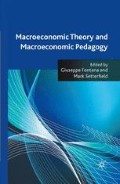Abstract
The evolution of the textbook treatment of macroeconomics and monetary economics would be a fascinating subject in its own right, for anyone with the time and energy to pursue it. From the publication of the first modern textbooks in the late 1940s, up to the early 1970s, so-called ‘Keynesian’ models,1 stressing the importance of aggregate demand, were the order of the day (even if some bore little resemblance to anything in the writings of J.M. Keynes). Then, from roughly the late 1970s to the early 1990s, standard textbook fare was clearly based on monetarism,2 the twentieth-century version of the quantity theory of money, actually with something of a lag compared to events in the real world, as in practice central banks had been forced to abandon the monetary targeting experiments of the 1979–82 period almost as soon as they had started. Finally, from the mid-1990s onwards a new textbook orthodoxy has developed in the form of a simple three-equation neo-Wicksellian model, the most salient features of which are that the monetary policy instrument is an interest rate (the ‘policy rate’), and that the supply of money and credit becomes endogenous. The reason for this latest change is that it became impossible for textbook orthodoxy to go on making statements to the effect that central banks ‘cannot control interest rates’ and so on, at a time when the central banks themselves were saying and doing the opposite (for example, by posting interest rate targets on their websites and publicizing any changes), and questions of interest rate policy had become close to an obsession in the news media dealing with financial affairs.
Access this chapter
Tax calculation will be finalised at checkout
Purchases are for personal use only
Preview
Unable to display preview. Download preview PDF.
References
Ackley, G. (1978), Macroeconomics Theory and Policy, New York: Macmillan.
Atesoglu, H.S. and Smithin, J. (2006), ‘Inflation targeting in a simple macroeconomic model’, Journal of Post Keynesian Economics, 28, 4, 673–88.
Atesoglu, H.S. (2007), ‘Un modelo macroeconomico simple’, Economia Informa, 346, May–June, 105–19.
Barrows, D. and Smithin, J. (2006), Fundamentals of Economics for Business, Toronto: Captus Press.
Cecchetti, S.G. (2006), Money, Banking, and Financial Markets, New York: McGraw-Hill Irwin.
Dornbusch, R. and Fischer, S. (1978), Macroeconomics, New York: McGraw-Hill.
Humphrey, T.M. (1993), Money, Banking and Inflation: Essays in the History of Monetary Thought, Cheltenham: Edward Elgar.
Isaac, A.G. (1999), ‘Inflation: conflicting claims approach’, in O’Hara, P. (ed.), Encyclopedia of Political Economy, Volume 1, London: Routledge, 508–10.
Keynes, J.M. (1936), The General Theory of Employment Interest and Money, London: Macmillan.
Mankiw, N.G. (1992), Macroeconomics, New York: Worth.
Mankiw, N.G. (2001), ‘US monetary policy during the 1990s’, NBER Working Paper no. 8471, September.
Smithin, J. (2007), ‘Aggregate demand and supply’, in Forstater, M., Mongiovi, G. and Pressman, S. (eds), Post Keynesian Macroeconomics: Essays in Honour of Ingrid Rima, London: Routledge, 108–28.
Smithin, J. (2009), Money, Enterprise and Income Distribution: Towards a Macroeconomic Theory of Capitalism, London and New York: Routledge.
Taylor, J.B. (1993), ‘Discretion versus policy rules in practice’, Carnegie-Rochester Conference Series on Public Policy, 39, 195–214.
Taylor, J.B. (2000), ‘Teaching modern macroeconomics at the principles level’, American Economic Review, 90, 90–4.
Taylor, J.B. (2007), Principles of Macroeconomics, 5th edn, Boston: Houghton Mifflin.
Thornton, H. (1962 [1802]), An Inquiry into the Nature and Effects of the Paper Credit of Great Britain, New York: Augustus M. Kelley.
Wicksell, K. (1965 [1898]), Interest and Prices: A Study of the Causes Regulating the Value of Money, New York: Augustus M. Kelley.
Editor information
Editors and Affiliations
Copyright information
© 2009 John Smithin
About this chapter
Cite this chapter
Smithin, J. (2009). Teaching the New Consensus Model of ‘Modern Monetary Economics’ from a Critical Perspective: Pedagogical Issues. In: Fontana, G., Setterfield, M. (eds) Macroeconomic Theory and Macroeconomic Pedagogy. Palgrave Macmillan, London. https://doi.org/10.1007/978-0-230-29166-9_14
Download citation
DOI: https://doi.org/10.1007/978-0-230-29166-9_14
Publisher Name: Palgrave Macmillan, London
Print ISBN: 978-0-230-27763-2
Online ISBN: 978-0-230-29166-9
eBook Packages: Palgrave Economics & Finance CollectionEconomics and Finance (R0)

